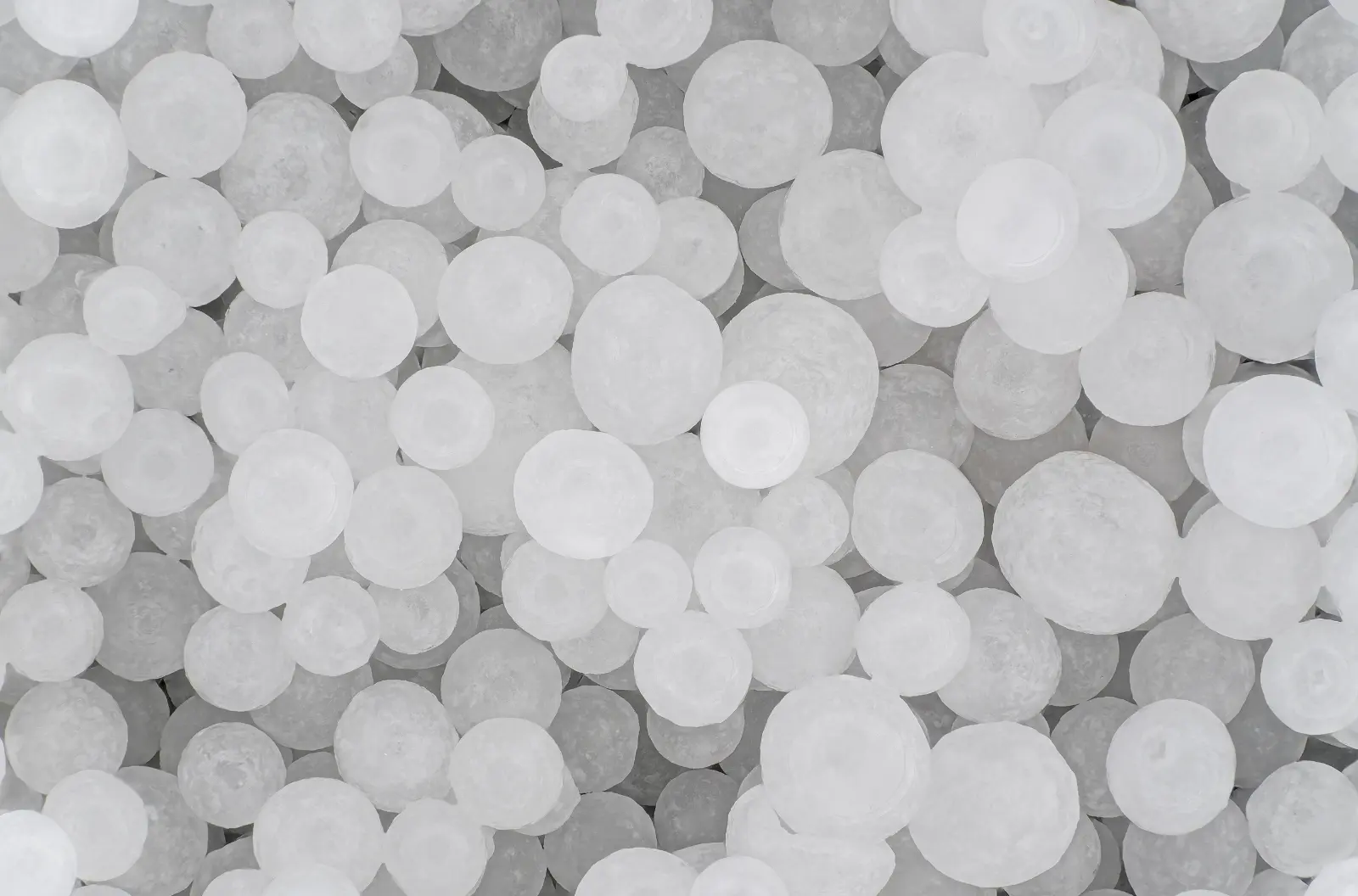The process begins with the preparation of brine, a concentrated solution of sodium chloride (table salt) and water. The brine is purified to remove impurities that could affect the efficiency of the process.
The purified brine undergoes electrolysis, a method that uses an electric current to drive a chemical reaction. This is done in an electrolytic cell, which is divided into two compartments by a membrane or diaphragm. The cell contains electrodes: an anode (positive) and a cathode (negative).
At the Anode: Chloride ions (Cl-) from the sodium chloride solution are oxidized to form chlorine gas (Cl2).
At the Cathode: Water molecules are reduced, producing hydrogen gas (H2) and hydroxide ions (OH-).
The hydroxide ions produced at the cathode combine with the sodium ions (Na+) in the solution to form sodium hydroxide (NaOH). This reaction occurs in the cathode compartment of the electrolytic cell.
The resulting sodium hydroxide solution is collected and can be further concentrated and purified, depending on the desired concentration and purity levels for its intended use. The solution can be evaporated to produce solid sodium hydroxide in the form of flakes, pellets, or granules.
The chloralkali process also produces chlorine gas and hydrogen gas as by-products. These gases are collected and utilized in various industrial applications, ensuring minimal waste and maximizing resource efficiency.
Throughout the production process, rigorous quality control measures are implemented to ensure the sodium hydroxide meets industry standards and specifications. This includes monitoring the purity, concentration, and overall quality of the final product.
Sodium hydroxide is formed through a chemical reaction between sodium ions (Na+) and hydroxide ions (OH-). This reaction is typically represented by the equation:
The most common industrial method for forming sodium hydroxide is the electrolysis of brine, which is a concentrated solution of sodium chloride (NaCl) in water. This process is known as the chloralkali process and involves the following steps:
Preparation of Brine: A concentrated solution of sodium chloride is prepared. This solution, known as brine, serves as the starting material.
Electrolysis Process: The brine undergoes electrolysis in an electrolytic cell that consists of two electrodes: an anode and a cathode, separated by a membrane or diaphragm.
During electrolysis, the following reactions occur at the electrodes:
At the Anode: Chloride ions (Cl-) are oxidized to produce chlorine gas (Cl2).
At the Cathode: Water molecules are reduced to form hydrogen gas (H2) and hydroxide ions (OH-).
The hydroxide ions (OH-) generated at the cathode combine with the sodium ions (Na+) present in the solution to form sodium hydroxide (NaOH). This occurs in the cathode compartment of the electrolytic cell.
The sodium hydroxide formed in the electrolytic cell is collected as an aqueous solution. Depending on the desired concentration and purity, this solution may undergo further processing, such as evaporation, to concentrate it into solid forms like flakes, pellets, or granules.
The chloralkali process also produces chlorine gas (Cl2) and hydrogen gas (H2) as by-products. These gases are captured and utilized in various other industrial applications, ensuring efficient use of all generated substances.
The formation of sodium hydroxide through the electrolysis of brine is a well-established and efficient process. By understanding the chemical reactions and industrial procedures involved, we can appreciate how this essential chemical is produced to meet the demands of various industries. The chloralkali process ensures high-purity sodium hydroxide, crucial for applications in manufacturing, chemical processing, water treatment, and more.
Sodium Hydroxide (NaOH), commonly known as caustic soda or lye, is a highly caustic substance that requires careful handling and disposal to prevent harm to people, property, and the environment. Proper disposal methods are essential to ensure safety and regulatory compliance. Here’s a detailed guide on how to dispose of sodium hydroxide:
Before disposing of sodium hydroxide, it is important to identify the quantity and concentration of the substance. This information is crucial for determining the appropriate disposal method.
One of the safest ways to dispose of sodium hydroxide is by neutralizing it. This process involves the following steps:
Prepare a Neutralizing Agent: Common neutralizing agents include dilute hydrochloric acid (HCl) or acetic acid (vinegar). Ensure you have enough of the neutralizing agent to react with the sodium hydroxide.
Slow Addition: Slowly add the neutralizing agent to the sodium hydroxide solution. This should be done in a well-ventilated area, preferably in a fume hood. Always add the acid to the base, not the other way around, to minimize the risk of a violent reaction.
Monitoring pH: Continuously monitor the pH of the solution during the neutralization process. The goal is to achieve a neutral pH of around 7. Use pH test strips or a pH meter for accurate measurements.
If neutralization is not feasible, another method is to dilute the sodium hydroxide solution. Follow these steps:
Large Volume of Water: Slowly dilute the sodium hydroxide with a large volume of water. This should be done gradually to prevent heat generation and splashing.
Dispose of in Accordance with Regulations: Once adequately diluted, the solution can be disposed of according to local regulations. Typically, small amounts of diluted sodium hydroxide can be poured down the drain with plenty of water, but always check with local waste disposal guidelines.
For larger quantities or if you are unsure about the disposal process, it is advisable to use professional hazardous waste disposal services. These services are equipped to handle and dispose of hazardous materials safely and in compliance with all regulations.
Never dispose of sodium hydroxide directly into the environment, such as on the ground or into waterways, as it can cause significant environmental harm. Always follow proper disposal methods to minimize environmental impact.
Disposing of sodium hydroxide safely and responsibly is crucial for protecting human health and the environment. Whether through neutralization, dilution, or professional disposal services, it is important to follow well-structured procedures and adhere to local regulations. By doing so, you ensure that sodium hydroxide is disposed of in a manner that mitigates risks and complies with safety standards.
Neutralizing sodium hydroxide (NaOH), also known as caustic soda, is an important procedure to ensure safety and environmental protection. Sodium hydroxide is a strong base, and its neutralization involves a controlled chemical reaction with an acid. Here’s a detailed guide on how to neutralize sodium hydroxide:
Neutralization is a chemical reaction between an acid and a base that results in the formation of water and a salt. The general reaction for neutralizing sodium hydroxide is:
This equation shows sodium hydroxide reacting with hydrochloric acid (HCl) to form sodium chloride (NaCl) and water.
To neutralize sodium hydroxide, you will need:
A neutralizing agent (commonly hydrochloric acid or acetic acid) pH test strips or a pH meter A container suitable for the neutralization process Before beginning the neutralization process, ensure you are wearing appropriate PPE to protect against splashes and chemical exposure. Work in a well-ventilated area, preferably under a fume hood.
Select an appropriate acid for neutralization. Hydrochloric acid (HCl) and acetic acid (vinegar) are commonly used. Dilute the acid if necessary, as concentrated acids can react violently with sodium hydroxide.
Add Acid to Base: Always add the acid to the sodium hydroxide solution, not the other way around. This minimizes the risk of a violent reaction.
Gradual Addition: Slowly pour the acid into the sodium hydroxide solution while stirring continuously. This helps to evenly distribute the acid and control the reaction rate.
Check pH Regularly: Use pH test strips or a pH meter to monitor the pH of the solution throughout the neutralization process.
Aim for Neutral pH: The goal is to achieve a neutral pH of around 7. Continue adding the acid slowly and checking the pH until the solution is neutralized.
Fine-Tune: If the pH overshoots and becomes acidic, you can carefully add a small amount of sodium hydroxide to bring it back to neutral.
Stir Well: Ensure the solution is thoroughly mixed and stable at a neutral pH.
Once neutralized, the solution can be disposed of according to local regulations. Small quantities of neutralized solution may be suitable for disposal down the drain with plenty of water, but always confirm with local waste disposal guidelines.
Neutralizing sodium hydroxide is a straightforward process that involves careful handling and controlled addition of an acid to achieve a neutral pH. By following proper procedures and safety precautions, you can effectively and safely neutralize sodium hydroxide, ensuring compliance with safety and environmental standards.





